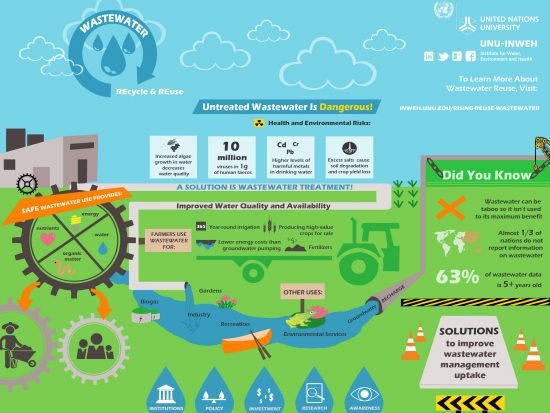Overcoming the Global Water Crisis: A Focus on Wastewater Recycling & Water Reuse
“Although two-thirds of our planet is water, we face an acute water shortage. The water crisis is the most pervasive, most severe, and most invisible dimension of the ecological devastation of the earth.”
— Vandana Shiva
While it is true that more than half of our planet’s surface is covered in water, a vast majority of it is saline. Fresh water, the water we use in hundreds of ways every day, constitutes only 2.5 % of all the water on the Earth. Today, the world faces what is known as the water crisis. Parts of the world do not have access to this most vital resource on the planet. Therefore, a focus on water recycling and water reuse is required to optimize the use of our critical water resources.
There are two sides to this water crisis: physical scarcity and economic scarcity. Physical water scarcity is what many of us imagine when we think of a water shortage. This type of scarcity is the physical lack of sources of freshwater to meet demand. The southwest U.S., the northern coast of Africa, Saudi Arabia, the Middle East, Australia, as well as part of SE Asia and Northern China all lack enough water sources to supply their people.
On the other hand, there are parts of the world, namely countries in Central and East Africa, face economic water scarcity. They have access to enough freshwater, but there is little to no management of the supplies and so people have limited access to it. In some places, there is no investment in the technology required to draw water from local sources. This is either due to a lack of money, or from a lack of human empathy on the part of governing powers in charge of such matters.
One particular contributor to the global water crisis is wastewater; the issue being that it is generally viewed as a wasted resource. Often times, the wastewater is treated just enough to avoid breaking regulations on water contamination. This treated water is discharged and new, fresh water is drawn from the local source. In addition, because of water scarcity, water prices are steadily rising. Therefore, discharging and obtaining new water can become a costly proposition. In both domestic and industrial settings, wastewater recycling and reuse could provide several sustainable benefits. This recycled water can be reused back into the process it came from, reused in another process, or it can be used in another sector or application.
Wastewater Recycling
Recycling wastewater would entail treating wastewater from a domestic or industrial process and reusing this water resource. This resource could be used for other typically non-potable processes, cooling or other domestic non potable applications. Using a wastewater recycling process, would reduce potable water usage for industrial applications and conserve it for drinking water.
Industrial process water is one such place that could be an opportunity for water recycling. For example, rinsing water could be recycled easily. Many industrial processes have a simple rinsing stage where a product is rinsed with water. This water is used to clean off any residual oils, paint, dust, sediment or other grime and could be easily recycled. The runoff rinse water is often collected below and sent to a waste tank that could contain waste from other processes. Instead, the runoff could be collected and sent to a modular treatment unit, processed, and then returned to a storage unit for rinse water.
Internal Water Reuse
Sometimes, water used in an industrial process may be costly to be reused for certain purposes based on economics. However, this water resource could be used in a different process within the same plant, such as cooling, irrigation, or another application. Perhaps clean, high quality water is needed to make a product, but another process in the plant doesn’t require water that is of such high quality, like washing machinery. The wastewater can be recycled and treated enough to be used in this particular application. Thereby, reducing the potential water costs and conserving potable water resources.
External Water Reuse
External water reuse can be classified as wastewater recycled for use outside of its internal production processes. This treated water can be used for external processes such as cleaning, cooling water, washing of equipment, or other potential applications.
In a pulp and paper mill, for example, high quality water is used for the paper making process to ensure a high quality paper product. The mill, instead of wasting the water used in this process, could recycle this water through a recycling process. This process would typically include specialized electrocoagulation, flotation, advanced oxidation and centrifugal filtration to utilize this particular treated water for such applications as external cooling, cleaning, or a washing process, among others.
By recycling wastewater and reusing process water, industries would not need to draw extensive freshwater sources that could be utilized more exclusively for potable water purposes.
Genesis Water Technologies, Inc. understands how imperative it is that more and more dedication be given to wastewater recycling and water reuse for both industrial and municipal applications. This is one strategy that can combat water scarcity.
With our advanced and innovative water treatment technologies, we work with companies and municipalities to figure out the most effective and effiicient way to treat their wastewater. Therefore, this water can be recycled and reused as a sustainable non potable water resource.
Worried about water scarcity? Want to do your part while reducing operating cost? To learn how wastewater recycling and reuse can reduce your business or municipalities cost, contact Genesis Water Technologies at 1-877-267-3699 in the USA. You can also reach us via email at customersupport@genesiswatertech.com for a no cost initial consultation of your particular application.


